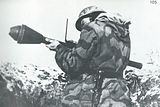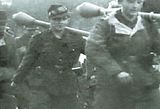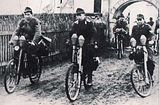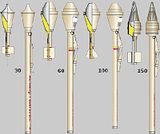


 Firing a panzerfaust
Firing a panzerfaust Diagram of panzerfaust types
Diagram of panzerfaust typesThe Panzerfaust or in English “Tank Fist”.
Development of the Panzerfaust started after the German infantry encountered the first heavy Russian tanks (T34 and KV series).
Several close assault weapons were developed.
A small hollow charge weapon in the form of a pylon, this weapon was magnetic and had to be attached to an enemy tank.
Good concept but still dangerous.
The infantry needed a weapon to engage tanks from ramnge to get into safety.
This eventually led to the Panzerfaust, this weapon finally provided infantry with the ability to knock out enemy tanks in close combat.
It was a single shot weapon, fire and forget, the launcher was thrown away after firing the warhead.
Several variants were made with range increasing with each new model, the early Panzerfaust 30 (1943), 60 (1944), 100 and 150.(1944/45)
Each faust could penetrate armor up to 200mm, at 90 degrees.
The Panzerfaust 30 had an effective range of 30 meters, while the Panzerfaust 60 was effective up to 60 meters. The 100 and 150 versions were effective up to 100 and 150 meters respectively.This was the effective range of each projectile, however for a good result the shooter had to be closer to its target (about 25%).
The Panzerfaust was made up of a projectile and cartridge, similar in concept to a bullet, a slug and shell. The cartridge had a shaped charge warhead.
The length of the weapon was about 104cm (42 inches) and weighed approximately 5.1kg (11.23 lbs). Later versions such as the Panzerfaust 100 weighed more at 6.8kgs (15 lbs), but the length remained largely unchanged.
When firing the weapon had a low recoil, the shooter had to take into account that the tube got lighter when the missile left the launcher causing the weapon to lift up.
The panzerfaust saw action on all fronts and was produced and distributed in large numbers.
pictures: Tamyia news, images of war, gun.re










